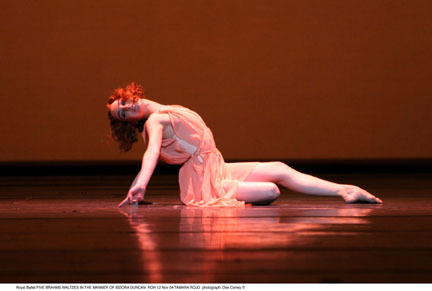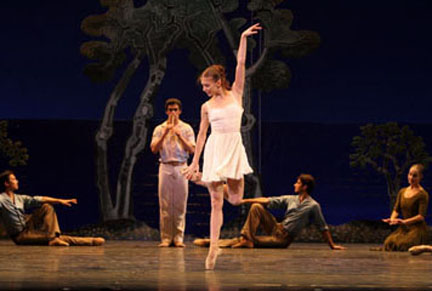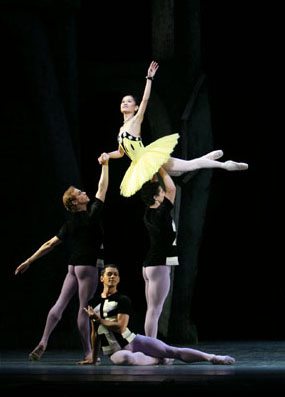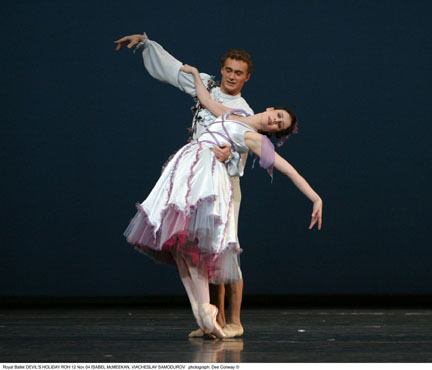Tribute to Ashton
“Scènes
de ballet”, “Divertissements”, “Daphnis and Chloe”
The Royal Ballet
Covent Garden ROH
London
November 13 – 25, 2004
by John Percival
copyright
© 2004 by John Percival
 Four
of Frederick Ashton’s full-evening ballets will be danced by the
Royal Ballet this season (i.e. all of them except “Romeo and Juliet”,
which the company never obtained—is it too late?), and nine of his
one-act works plus a group of divertissements. What might seem odd, however,
is that the shorter ballets are mainly offered on mixed bills with other
works by George Balanchine, David Bintley, Christopher Bruce, Kenneth
MacMillan, Bronislava Nijinska, Christopher Wheeldon. How well this will
work as an Ashton commemoration remains to be seen, but we have just had
the only all-Ashton mixed bill, and it was a real treat.
Four
of Frederick Ashton’s full-evening ballets will be danced by the
Royal Ballet this season (i.e. all of them except “Romeo and Juliet”,
which the company never obtained—is it too late?), and nine of his
one-act works plus a group of divertissements. What might seem odd, however,
is that the shorter ballets are mainly offered on mixed bills with other
works by George Balanchine, David Bintley, Christopher Bruce, Kenneth
MacMillan, Bronislava Nijinska, Christopher Wheeldon. How well this will
work as an Ashton commemoration remains to be seen, but we have just had
the only all-Ashton mixed bill, and it was a real treat.
The programme offered two familiar ballets and six short numbers including the British premiere of two dances from “Devil’s Holiday”. All but one of the roles had at least two casts, and it’s no surprise that which works pleased most depended on whom you caught on any given evening. The one constant factor was Tamara Rojo dancing the “Five Brahms Waltzes in the manner of Isadora Duncan”, and she was just magnificent. How did she get to do this better than anyone else? Was it through studying some of the many pictures of Duncan dancing, or did she acquire her understanding simply from her response to the music and movement, or by following supremely well the coaching by Lynn Seymour, for whom the role was created? Whatever the explanation, I found Ms. Rojo’s performance overwhelming and felt this was exactly what Ashton had wanted us to see, his memory of the great artist he watched as a young man. Ms. Rojo deserved a better pianist than the competent Philip Gammon (and he deserved to be amplified when playing the introduction behind the house curtain). But that apart—terrific.
 You
do know, don’t you, that artistic director Monica Mason got rid
of the appalling re-design commissioned by her predecessor-but-one, Anthony
Dowell, for “Daphnis and Chloe”? So we have this big, ambitious
ballet danced again in the setting wished for by its choreographer and
its original designer, the painter John Craxton, who was under 30 at the
time, and responsible for giving his beloved Greece a look at once timeless
and contemporary. “Daphnis”, the best current realisation
of Ravel’s great score, was already revived last season, and it
is gratifying that some of the dancers now show a stronger grasp of their
roles, which augurs well for the total effect of this Ashton season. The
better cast had Federico Bonelli partnering Alina Cojocaru’s debut
in the title roles, with Marianella Nunez as Lykanion, the young married
woman who teaches Daphnis how to make love, Thiago Soares as Dorkon (whose
designs on Chloe are not fulfilled), and José Martin as the pirate
chief Bryaxis. Happily, one of their performances was filmed by BBC tv.
You
do know, don’t you, that artistic director Monica Mason got rid
of the appalling re-design commissioned by her predecessor-but-one, Anthony
Dowell, for “Daphnis and Chloe”? So we have this big, ambitious
ballet danced again in the setting wished for by its choreographer and
its original designer, the painter John Craxton, who was under 30 at the
time, and responsible for giving his beloved Greece a look at once timeless
and contemporary. “Daphnis”, the best current realisation
of Ravel’s great score, was already revived last season, and it
is gratifying that some of the dancers now show a stronger grasp of their
roles, which augurs well for the total effect of this Ashton season. The
better cast had Federico Bonelli partnering Alina Cojocaru’s debut
in the title roles, with Marianella Nunez as Lykanion, the young married
woman who teaches Daphnis how to make love, Thiago Soares as Dorkon (whose
designs on Chloe are not fulfilled), and José Martin as the pirate
chief Bryaxis. Happily, one of their performances was filmed by BBC tv.
That same night also saw the best of three casts in the other main work,
“Scènes de ballet”, with Miyako Yoshida and Ivan Putrov
in the leads. A little thought apropos “Scènes”: Ashton
may well have wanted to make it watchable from any angle, as he is often
quoted; but surely it is time to recognise that it didn’t end up
that way. The choreography quite definitely has a front, back and sides;
this adds  to
the strong theatricality it possesses in spite of having no lot. Amazing
to think that when the ballet was new in 1948, we all found Stravinsky’s
score very difficult going, yet now it seems so tuneful that one can easily
sing along with it.
to
the strong theatricality it possesses in spite of having no lot. Amazing
to think that when the ballet was new in 1948, we all found Stravinsky’s
score very difficult going, yet now it seems so tuneful that one can easily
sing along with it.
I was not bowled over by all the divertissements. The Awakening pas de deux, for instance, which Ashton made for a new “Sleeping Beauty” production in 1968, though it had worked pleasantly in that context, is a rather mild-mannered piece to do on its own, especially with Darcey Bussell looking off form or her alternate Jaimie Tapper out of place. Reticent applause suggested that the audience agreed with me. And we do seem to get the “Thais (Meditation) pas de deux” often enough that it could have given way to something less familiar. Soares made much of the male role, with Mara Galeazzi; the other cast had Bonelli supporting the new recruit from Boston, Sarah Lamb, in her RB solo debut. I’m sorry to say that she made sadly little impression on me in this; better luck another time, perhaps.
The duet “Voices of Spring” came off more excitingly. A brash showpiece, originally given as an extra in the opera “Die Fledermaus”, it was danced with inimitable bravura by the crisp-stepping Leanne Benjamin and the exuberant Carlos Acosta. Their alternates, Galeazzi and Viacheslav Samodurov, were only marginally less brilliant, and seemed to find even more fun in the number (was Ashton just slightly sending up the showing-off quality of his original cast, Merle Park and Wayne Eagling?)
 What
about the two dances from “Devil’s Holiday”, never seen
on stage by their choreographer thanks to war breaking out in September
1939, and now receiving their London premiere just 65 years later? Yes,
American audiences have already had the chance to see them, but the comments
I had read gave me little idea what to expect. The solo and duet were
given separately (with the Isadora dances between them). I felt that these
numbers were not ideal to be seen out of context—they clearly carried
a meaning and we were not told even who the characters were, nor the plot
they fitted into. All the same, naturally I was delighted to see some
unfamiliar choreography by Ashton, and grateful to the incredible memory
of Frederic Franklin who originally danced and has now staged them. Martin
Harvey, whom I saw first, was a replacement for the announced Ricardo
Cervera, and perhaps through limited preparation he seemed to me not to
have got to grips with the role. But Viasheslav Samodurov, in the other
cast, really did convey what Mr. Franklin describes in a programme quote
as Ashton’s wish for “the emotion to come through the choreography
… to express through the arms and the body” without making
any faces. “Choreography for male dancers today tends to emphasise
the technical more than the lyrical aspects of dancing”, Franklin
says, and he and Samodurov have succeeded here in achieving the lyrical
quality of the solo, with evocative ports de bras and frequent descents
to the floor. A pity that Isabel McMeekan, in this cast, didn’t
succeed so well with the duet; Laura Morera had made more of it with Mr.
Harvey. However, these dances were warmly welcomed by the audience, who
enthusiastically greeted Franklin too when he took a call with his casts.
There can have been few of us present who remembered him as a dancer (yes,
such an expressive one), but it was good to see him again on stage, although
in street clothes. And it is pleasing that, despite spending most of his
career in America, this Englishman’s life work was acknowledged
by appointment as CBE (Coatmmander of the Most Honourable Order of the
British Empire) which the Queen conferred on him at Buckingham Palace
during his stay.
What
about the two dances from “Devil’s Holiday”, never seen
on stage by their choreographer thanks to war breaking out in September
1939, and now receiving their London premiere just 65 years later? Yes,
American audiences have already had the chance to see them, but the comments
I had read gave me little idea what to expect. The solo and duet were
given separately (with the Isadora dances between them). I felt that these
numbers were not ideal to be seen out of context—they clearly carried
a meaning and we were not told even who the characters were, nor the plot
they fitted into. All the same, naturally I was delighted to see some
unfamiliar choreography by Ashton, and grateful to the incredible memory
of Frederic Franklin who originally danced and has now staged them. Martin
Harvey, whom I saw first, was a replacement for the announced Ricardo
Cervera, and perhaps through limited preparation he seemed to me not to
have got to grips with the role. But Viasheslav Samodurov, in the other
cast, really did convey what Mr. Franklin describes in a programme quote
as Ashton’s wish for “the emotion to come through the choreography
… to express through the arms and the body” without making
any faces. “Choreography for male dancers today tends to emphasise
the technical more than the lyrical aspects of dancing”, Franklin
says, and he and Samodurov have succeeded here in achieving the lyrical
quality of the solo, with evocative ports de bras and frequent descents
to the floor. A pity that Isabel McMeekan, in this cast, didn’t
succeed so well with the duet; Laura Morera had made more of it with Mr.
Harvey. However, these dances were warmly welcomed by the audience, who
enthusiastically greeted Franklin too when he took a call with his casts.
There can have been few of us present who remembered him as a dancer (yes,
such an expressive one), but it was good to see him again on stage, although
in street clothes. And it is pleasing that, despite spending most of his
career in America, this Englishman’s life work was acknowledged
by appointment as CBE (Coatmmander of the Most Honourable Order of the
British Empire) which the Queen conferred on him at Buckingham Palace
during his stay.
Photos (all
by Dee Conway):
First: Tamara Rolo in "Five Brahms Wzltzes in the Manner of
Isadora Duncan."
Second: Alina Cojocaru and Federico Bonelli in "Daphnis and
Chloe."
Third: Miyoko Yoshida held aloft in "Scenes de ballet."
Fourth: Isabelle McKeekan, Viasheslav Samodurov in the pas de deux
from "Devil's Holiday". Photo: Dee
Conway.
Volume
2, No. 44
November 22, 2004
www.danceviewtimes.com
Copyright
©2004 by John Percival
|
|
|